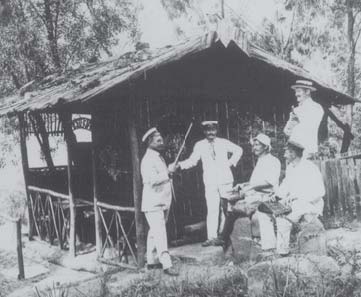While Berrima Camp was formally controlled by the Australian Army, the day-to-day management was left largely to the Camp Committee consisting of ships’ captains, officers and seamen. The Committee dealt with the organisation of the camp in liaison with the Camp Commandant.
Gymnastics, wrestling, football, swimming and athletics were organised to promote health and fitness. Work parties cleared and prepared the sporting areas and vegetable gardens.
Funding came from the camp canteen which was managed as a commercial enterprise. The internees ran it to trade German delicacies from Sydney. This enabled the purchase of vegetable seeds, the renting of grounds for the growing of crops, buying instruments for the camp orchestra and purchasing materials to make Christmas presents for the children of the camp. Funds were also used to employ internees who received no wages from their companies.
Education classes were established. English was popular as all letters sent out of the camp had to be written in English. Other classes included theatre, music, carpentry, joinery, shorthand, photography, sketching and painting. Classes on navigation and marine skills were given by Captains for juniors aiming to take qualifying examinations after the war. Wireless courses were popular as simple crystal radios could pick up local transmissions. Often the internees knew the latest world news well before the villagers.
Camp improvements were carried out by the internees that included the introduction of a water supply from the river and the installation of a generator well before the village received power. This was no doubt driven by the internees’ theatre group for more flexible stage lighting.
Many of the shipping companies’ shore-based employees had lived in Australia for some time before the war. Most had Australian friends who provided many books to the camp library that had been transported complete from the German Club in Singapore. The Committee also supplied books. The library contained books relevant to the various classes held and a comprehensive collection of German classics and general literature.
Family Life
There were five families that sought to be close to their husbands and fathers in the camp: the Hurtzigs, Glinzs, Jepsons, Brauns and Wallners. Later the Machotka family arrived to discover that most of the suitable rental houses had been taken by internees.
The Glinz and Hurtzig families had to share a house. This house was the large, two storeyed stone house that still stands outside the south-eastern corner of the gaol. It had been the residence of the Gaol Superintendent and for a while the Guard. Frau Hurtzig would never have moved had her husband told her how dirty the place was. Frau Hurtzig wrote in her diary, I pray never again to have to clean up after a mob of soldiers. The large house conveniently divided into two self-contained areas by closing and locking several of the internal doors. In August 1918 all internees with families were relocated to Molonglo Camp.
Two other identifiable houses that still stand in Berrima were occupied by the Brauns and the Wallners. The Brauns initially lived in the house now named Sovereign Cottage, in Argyle Street next to the court house. Later they moved and the Wallners moved in. Frau Jepsen eventually moved from the boarding house and took a cottage which, according to Frau Hurtzig was so far away from us that she could neither hear the sounds of the soldiers nor see the activities at the camp.
Die Deutsche Tochterschule Berrima: The German Girls’ School Berrima
The Tochterschule was housed in a bark hut located on the right bank of the river upstream from the Hansa Bridge. It was easily reached by the girls who had only to step from their houses and walk a short distance from the village.
The Committee equipped the Tochterschule with a blackboard, tables, chairs, books, charts and writing slates. Subjects offered depended on the availability of competent people to teach, with a good range of subjects offered.


